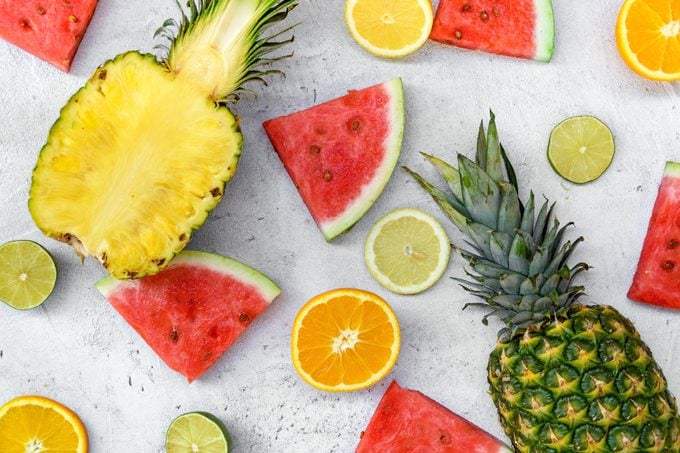Is Pineapple a Citrus Fruit?
Updated: Jun. 15, 2021
Pineapple is tangy and sweet, with plenty of vitamin C. But that doesn't make it a citrus fruit. Here's what you need to know, including its nutrition, health benefits, and how to avoid "pineapple mouth."
Is pineapple citrus?
Spoiler: A pineapple is neither a pine nor an apple. It got its name from early European colonizers in South America who thought the spiky outside looked like a pine cone and the pulpy flesh tasted kind of like an apple.
This strange name has led to a lot of confusion in selling, eating, and preparing pineapple ever since, says Monica Nedeff, RDN and founder of The Traveling Dietitian.
But even if people don’t know exactly what it is, they know they love it. It’s one of the most popular fruits, perhaps because it’s one of the sweetest, with 12 grams of sugar per serving.
Or it may be because it’s found in so many favorite desserts, like pineapple upside down cake and the classic summer treat, the Dole Whip.
But beyond its “sweet-n-spiky” status, the fruit kind of defies categorization.
With its high vitamin C content, you may be wondering, “Is pineapple citrus?” Here’s everything you need to know about this mysterious yet common fruit.
But first, the definition of a fruit
Technically, a fruit is the fleshy product that develops from the flower of a tree, bush, or plant. It contains the seeds. Generally, we think of fruit as any sweet, edible part of a plant.
Scientists categorize fruits into groups based on how they are formed on the plant: simple, aggregate, and multiple.
Instead, most folks sort fruit into one of seven unofficial but practical categories, based on their skin, seeds, and flavor.
-
Pome fruits: A core of seeds surrounded by a comparatively large amount of flesh and covered with a thin, edible skin. Think apples and pears.
-
Drupes or stone fruits: One large seed surrounded by a moderate amount of flesh and covered with a thin, edible skin. Think peaches, plums, and apricots.
-
Citrus: Pulpy insides containing a few seeds that are surrounded by a spongy or leathery inedible skin. Think grapefruits, lemons, and oranges.
-
Berries: Soft, juicy fruits that contain many seeds, either on the outside or the inside. Think strawberries, blackberries, and blueberries.
-
Melons: A large fruit from the gourd family with a hard outer rind, firm insides, and containing many seeds. Think watermelon, cantaloupe, and honeydew.
-
Tropical: These are fruits native to tropical regions and can also belong to other categories listed above. Think bananas, guava, and mangoes.
-
Vegetables that are really fruits: There is a large group of foods most people classify as veggies that are, by definition, fruits. These include tomatoes, cucumbers, avocados, squash, beans, and eggplant.
So what type of fruit is a pineapple?
A pineapple, scientifically speaking, is a “multiple” fruit because it forms from multiple flowers that fuse together.
Citrus fruits, on the other hand, are classified as “simple” and put in their own citrus category.
Generally speaking, the sweet and tangy fruit is considered a tropical fruit due to its native climate.
So by both the scientific and general definitions, a pineapple is not a citrus fruit.

Citrus fruits are actually berries
Ready to have your mind blown? In scientific terms, most of what we think of as berries aren’t true berries.
Blueberries, cranberries, and gooseberries are berries by definition, while strawberries, raspberries, and blackberries aren’t true berries.
It gets more confusing: plenty of foods that we’d put in a different category—like bananas, grapes, cucumbers, chili peppers, and oranges—are technically berries.
Berries are a “simple” fruit grown from a single ovary on the plant.
Citrus fruits are a subtype of berry called a hesperidium, meaning they have pulpy, sectioned insides surrounded by a peelable, spongy or firm rind.
Grapefruits, lemons, limes, kumquats, pummelos, and the many types of oranges are all classified as citrus fruits or “simple hesperida.”
(Try acai berry to reap more health benefits.)
Pineapple nutrition facts
One cup (165 grams) of pineapple chunks contains the following nutrients and recommended daily values (DV):
Calories: 83
Fat: 0.2 g (0 percent DV)
Protein: 0.9 g (2 percent DV)
Carbs: 22 g (8 percent DV)
Fiber: 2.3 grams (8 percent DV)
Sugar: 16 g
Protein: 0.9 g (2 percent DV)
Calcium: 21.45 mg (2 percent)
Iron: 0.48 mg (3 percent DV)
Potassium: 180 mg (4 percent DV)
Vitamin C: 78.9 mg (88 percent DV)
Health benefits of pineapple
Fruits in general are quite good for you, reducing your risk for many diseases and potentially helping to increase your lifespan.
Yet pineapples sometimes get a bad rap for being high in sugar.
It’s true that it has more natural sugar than some other types of fruit—22 grams of carbohydrate, 16 grams of which is from sugar. Compare that with cantaloupe’s 12.7 grams of carbs and 12 grams of sugar. But that doesn’t mean you shouldn’t eat pineapple.
Pineapples have some impressive health benefits, says Trista Best, registered dietitian, adjunct nutrition professor, and a consultant with Balance One Supplements.
And it’s not just the flesh that is good for you. Don’t throw away that peel—you can use pineapple rinds to make a nutritious and delicious drink called Tepache.
Anti-inflammatory
Pineapple is the only food source of bromelain, a digestive enzyme with powerful anti-inflammatory properties, which may help boost your immune system and help you recover from illnesses faster.
Natural cold medicine
Pineapple’s bromelain content may make it beneficial in the treatment of colds and coughs, says Best.
It also acts as a mucolytic, meaning it can break down mucus, a common irritant in colds that leads to coughs and sore throats.
Immune booster
Pineapple is an excellent source of vitamin C. Just one cup of pineapple provides about 80 milligrams, or 88 percent of the recommended daily value of this immune-supporting vitamin.
Vitamin C has a host of additional health benefits, including promoting stronger teeth and bones. And it may help with depression.
Why does pineapple hurt my mouth?
If there is one downside to eating pineapple, it’s that eating too much of it can cause your mouth to sting and burn.
You may even get little sores or raw spots on the corners of your mouth and edges of your tongue. That, too, has to do with the bromelain.
As a digestive enzyme, it’s particularly good at breaking down proteins in meat—and that includes the flesh of your mouth.
And because bromelain reduces mucus, it dissolves the protective coating of mucus on the inside of your mouth, making it more sensitive and vulnerable to the digestive juices in your mouth and the acid in the pineapple.
You can prevent pineapple mouth by eating the fruit in moderation.
Have a hard time stopping at just a few pieces? There is a trick to reducing the stinging, burning effect: grill your pineapple, says Nedeff.
Not only will cooking the fruit caramelize the sugars and make it even tastier, but the heat also breaks down the enzymes, making them less likely to sting your mouth.
Pineapple and citrus are a perfect match
Just because pineapple isn’t a citrus fruit doesn’t mean you can’t eat them together.
Eating them together brings out the bright, tangy flavors of each fruit while giving you a good intake of vitamin C.
Ready to cook with pineapple? Try these recipes:
Add them to a fruit salad, whip them into a tangy marinade or barbecue sauce, or try them together in one of our weight-loss smoothie recipes.
Next, find out if pineapple juice can help get rid of warts.





















